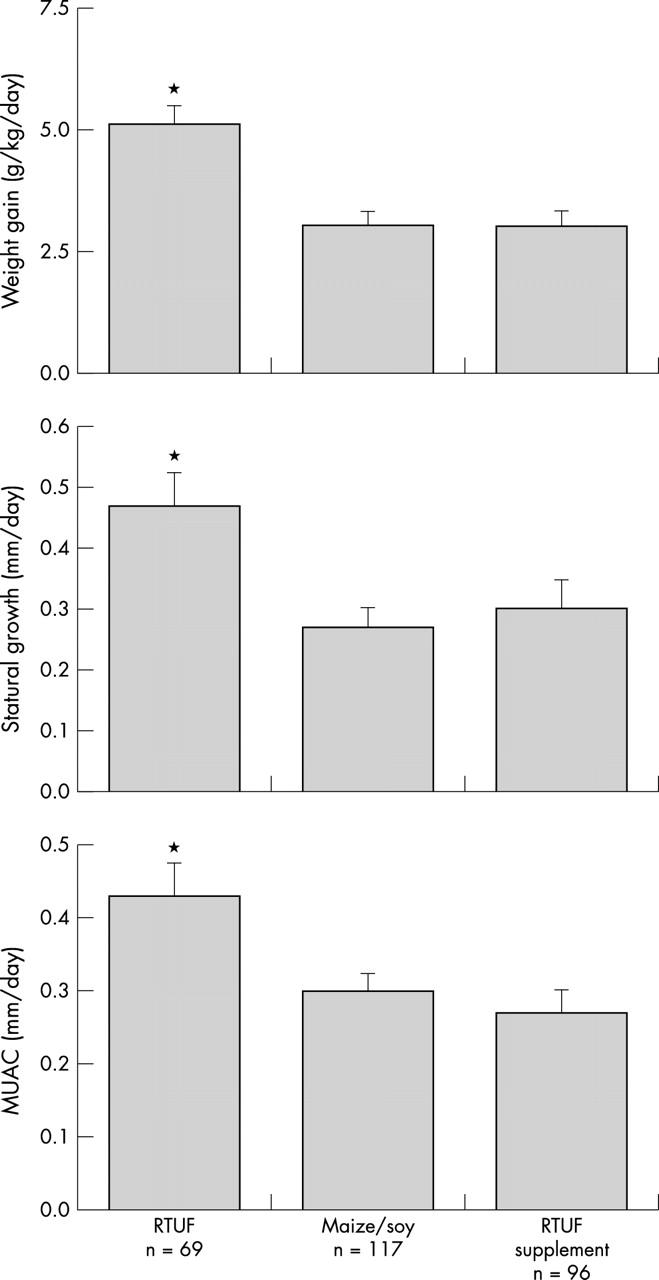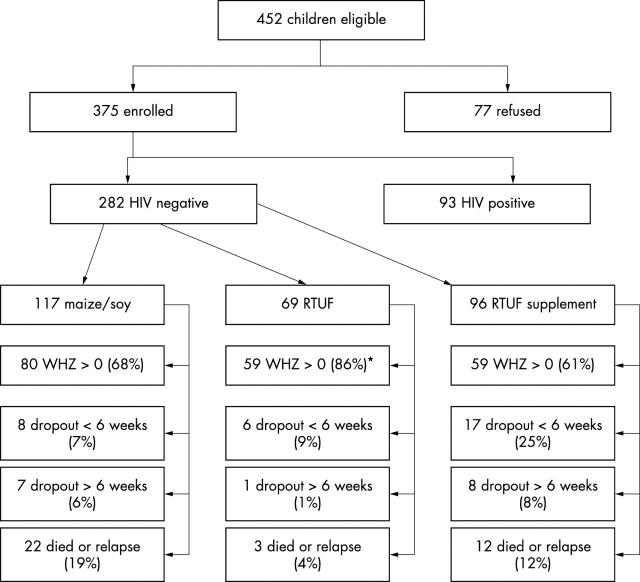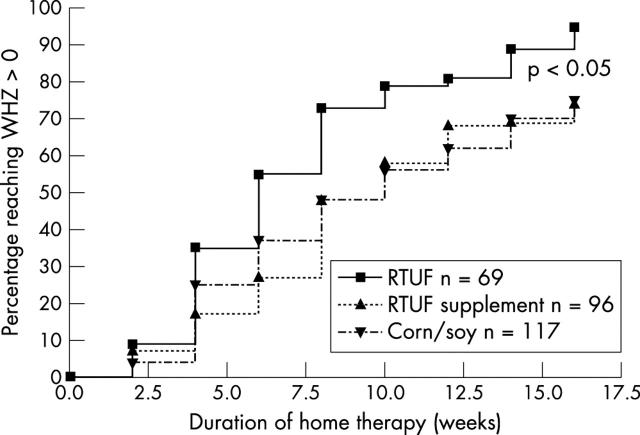Abstract
Background: The standard treatment of severe malnutrition in Malawi often utilises prolonged inpatient care, and after discharge results in high rates of relapse.
Aims: To test the hypothesis that the recovery rate, defined as catch-up growth such that weight-for-height z score >0 (WHZ, based on initial height) for ready-to-use food (RTUF) is greater than two other home based dietary regimens in the treatment of malnutrition.
Methods: HIV negative children >1 year old discharged from the nutrition unit in Blantyre, Malawi were systematically allocated to one of three dietary regimens: RTUF, RTUF supplement, or blended maize/soy flour. RTUF and maize/soy flour provided 730 kJ/kg/day, while the RTUF supplement provided a fixed amount of energy, 2100 kJ/day. Children were followed fortnightly. Children completed the study when they reached WHZ >0, relapsed, or died. Outcomes were compared using a time-event model.
Results: A total of 282 children were enrolled. Children receiving RTUF were more likely to reach WHZ >0 than those receiving RTUF supplement or maize/soy flour (95% v 78%, RR 1.2, 95% CI 1.1 to 1.3). The average weight gain was 5.2 g/kg/day in the RTUF group compared to 3.1 g/kg/day for the maize/soy and RTUF supplement groups. Six months later, 96% of all children that reached WHZ >0 were not wasted.
Conclusions: Home based therapy of malnutrition with RTUF was successful; further operational work is needed to implement this promising therapy.
Full Text
The Full Text of this article is available as a PDF (140.1 KB).
Figure 1 .
Trial profile. WHZ, anthropometric weight-for-height z score; RTUF, ready-to-use food.
Figure 2 .
Time to reach full catch-up growth, WHZ >0 based on initial height. The fraction reaching WHZ >0 is greater in the RTUF group (Kaplan-Meier time event analysis, RR 1.2, 95% CI 1.1 to 1.3).
Figure 3 .

Weight gain, statural growth, and mid-upper arm circumference (MUAC) growth in the three dietary groups of home based therapy. *Denotes greater than the other two groups, determined by Student's t test, p<0.01.
Selected References
These references are in PubMed. This may not be the complete list of references from this article.
- Abbassy A. S., el-Din M. K., Hassan A. I., Aref G. H., Hammad S. A., el-Araby I. I., el-Din A. A. Studies of cell-mediated immunity and allergy in protein energy malnutrition. II. Immediate hypersensitivity. J Trop Med Hyg. 1974 Jan;77(1):18–21. [PubMed] [Google Scholar]
- Ashworth A., Millward D. J. Catch-up growth in children. Nutr Rev. 1986 May;44(5):157–163. doi: 10.1111/j.1753-4887.1986.tb07613.x. [DOI] [PubMed] [Google Scholar]
- Brewster D. R., Manary M. J., Graham S. M. Case management of kwashiorkor: an intervention project at seven nutrition rehabilitation centres in Malawi. Eur J Clin Nutr. 1997 Mar;51(3):139–147. doi: 10.1038/sj.ejcn.1600367. [DOI] [PubMed] [Google Scholar]
- Briend A. Highly nutrient-dense spreads: a new approach to delivering multiple micronutrients to high-risk groups. Br J Nutr. 2001 May;85 (Suppl 2):S175–S179. [PubMed] [Google Scholar]
- Briend A., Lacsala R., Prudhon C., Mounier B., Grellety Y., Golden M. H. Ready-to-use therapeutic food for treatment of marasmus. Lancet. 1999 May 22;353(9166):1767–1768. doi: 10.1016/S0140-6736(99)01078-8. [DOI] [PubMed] [Google Scholar]
- Collins S. Changing the way we address severe malnutrition during famine. Lancet. 2001 Aug 11;358(9280):498–501. doi: 10.1016/S0140-6736(01)05630-6. [DOI] [PubMed] [Google Scholar]
- Collins Steve, Sadler Kate. Outpatient care for severely malnourished children in emergency relief programmes: a retrospective cohort study. Lancet. 2002 Dec 7;360(9348):1824–1830. doi: 10.1016/S0140-6736(02)11770-3. [DOI] [PubMed] [Google Scholar]
- Diop El Hadji Issakha, Dossou Nicole Idohou, Ndour Marie Madeleine, Briend André, Wade Salimata. Comparison of the efficacy of a solid ready-to-use food and a liquid, milk-based diet for the rehabilitation of severely malnourished children: a randomized trial. Am J Clin Nutr. 2003 Aug;78(2):302–307. doi: 10.1093/ajcn/78.2.302. [DOI] [PubMed] [Google Scholar]
- Fjeld C. R., Schoeller D. A., Brown K. H. A new model for predicting energy requirements of children during catch-up growth developed using doubly labeled water. Pediatr Res. 1989 May;25(5):503–508. doi: 10.1203/00006450-198905000-00016. [DOI] [PubMed] [Google Scholar]
- Holt P. G. Parasites, atopy, and the hygiene hypothesis: resolution of a paradox? Lancet. 2000 Nov 18;356(9243):1699–1701. doi: 10.1016/S0140-6736(00)03198-6. [DOI] [PubMed] [Google Scholar]
- Kasper H. Faecal fat excretion, diarrhea, and subjective complaints with highly dosed oral fat intake. Digestion. 1970;3(6):321–330. doi: 10.1159/000197052. [DOI] [PubMed] [Google Scholar]
- Khanum S., Ashworth A., Huttly S. R. Controlled trial of three approaches to the treatment of severe malnutrition. Lancet. 1994 Dec 24;344(8939-8940):1728–1732. doi: 10.1016/s0140-6736(94)92885-1. [DOI] [PubMed] [Google Scholar]
- Pelletier D. L., Low J. W., Johnson F. C., Msukwa L. A. Child anthropometry and mortality in Malawi: testing for effect modification by age and length of follow-up and confounding by socioeconomic factors. J Nutr. 1994 Oct;124(10 Suppl):2082S–2105S. doi: 10.1093/jn/124.suppl_10.2082S. [DOI] [PubMed] [Google Scholar]
- Perra A., Costello A. M. Efficacy of outreach nutrition rehabilitation centres in reducing mortality and improving nutritional outcome of severely malnourished children in Guinea Bissau. Eur J Clin Nutr. 1995 May;49(5):353–359. [PubMed] [Google Scholar]
- Pécoul B., Soutif C., Hounkpevi M., Ducos M. Efficacy of a therapeutic feeding centre evaluated during hospitalization and a follow-up period, Tahoua, Niger, 1987-1988. Ann Trop Paediatr. 1992;12(1):47–54. doi: 10.1080/02724936.1992.11747546. [DOI] [PubMed] [Google Scholar]
- Schofield C., Ashworth A. Why have mortality rates for severe malnutrition remained so high? Bull World Health Organ. 1996;74(2):223–229. [PMC free article] [PubMed] [Google Scholar]
- Spady D. W., Payne P. R., Picou D., Waterlow J. C. Energy balance during recovery from malnutrition. Am J Clin Nutr. 1976 Oct;29(10):1073–1088. doi: 10.1093/ajcn/29.10.1073. [DOI] [PubMed] [Google Scholar]




